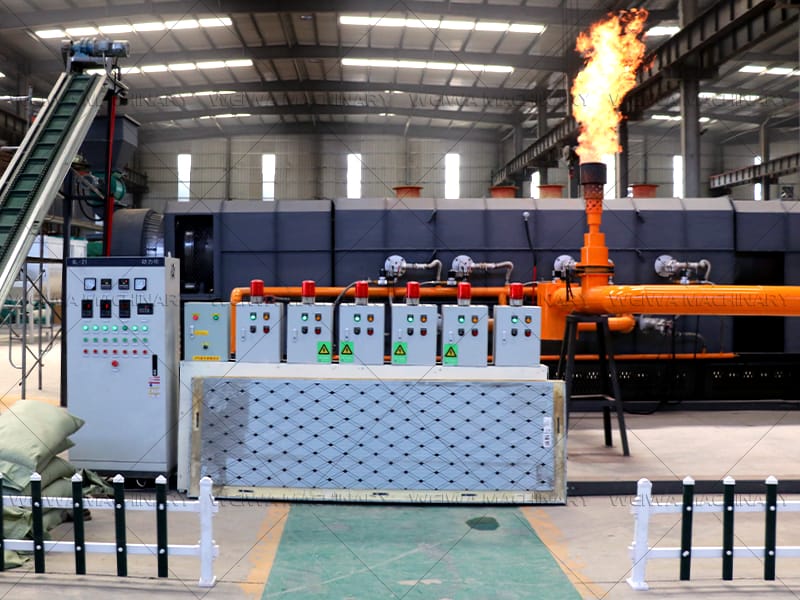Introduction to Tungku karbonisasi berkelanjutan Technology
Thetungku karbonisasi berkelanjutan has revolutionized biomass waste recycling, particularly for materials like palm shell, batok kelapa, dan keripik kayu. Unlike traditional batch-type furnaces, atungku karbonisasi berkelanjutan allows for uninterrupted processing, improving efficiency, reducing energy consumption, and ensuring consistent product quality.
How Does a Continuous Carbonization Furnace Work?
Atungku karbonisasi berkelanjutan operates by feeding biomass material (such as palm shell) into the furnace at a controlled rate while maintaining high temperatures (typically 400–600°C). The process involves:
1. Drying Stage
The raw material enters the preheating zone, where moisture is removed to prepare it for carbonization.
2. Carbonization Stage
Setelah dikeringkan, the material moves into the high-temperature zone, where pyrolysis occurs, breaking down organic compounds into charcoal, bio-oil, and syngas.
3. Discharge and Cooling
The carbonized product is continuously discharged while being cooled to prevent re-oxidation.
This continuous process eliminates the need for repeated loading and unloading, making it highly efficient for industrial-scale operations.
Why Palm Shell is an Ideal Feedstock for Carbonization
Palm shell, a byproduct of palm oil production, is widely available in Malaysia and Southeast Asia. Its high carbon content (~45-50%) and low ash make it an excellent material for producing high-quality charcoal.
Advantages of Using Palm Shell:
- Abundant supply in Malaysia
- Nilai kalori tinggi after carbonization
- Kadar air rendah (reduces pre-treatment needs)
- Eco-friendly waste recycling
Our Malaysian client chose palm shell as their primary feedstock due to its availability and profitability in the charcoal market.
Studi kasus: Malaysian Client’s Successful Trial at Weiwa Machinery
Baru-baru ini, a client from Malaysia visited our factory to test our tungku karbonisasi berkelanjutanDenganpalm shell. Here’s how the trial went:
1. Pre-Trial Preparation
Before the test, we discussed the client’s requirements, termasuk:
- Desired carbonization temperature
- Expected output capacity
- Fuel source (gas or biomass)
2. The Trial Process
The client brought palm shell samples, and we loaded them into the furnace. Key observations included:
- Stable temperature control (maintained at 500°C)
- Smooth feeding and discharge (no blockages)
- High-quality charcoal output (low ash, high fixed carbon)
3. Post-Trial Feedback
The client was impressed with:
- Efisiensi (continuous operation vs. batch processing)
- Low energy consumption
- Ease of operation
This successful trial reinforced our furnace’s reliability for palm shell carbonization in Malaysia.
Factors Influencing Continuous Carbonization Furnace Price
When considering a tungku karbonisasi berkelanjutan, price is a key factor. Namun, it’s essential to evaluate:
1. Kapasitas & Ukuran
Larger furnaces (higher output) cost more but offer better economies of scale.
2. Level Otomasi
Fully automated systems with PLC controls command a premium but reduce labor costs.
3. Fuel Type
Gas-fired furnaces are cleaner but may cost more upfront than biomass-fired ones.
4. Dukungan setelah penjualan
Our furnaces include installation guidance and maintenance support, adding long-term value.
For our Malaysian client, we provided a cost-effective solution tailored to their production needs.
Tentang Mesin Weiwa
ATMesin Weiwa, kami berspesialisasibiomass carbonization solutions, termasuktungku karbonisasi berkelanjutanUntukpalm shell, batok kelapa, and wood waste. With years of experience in Southeast Asia, kami menyediakan:
- Customized furnace designs
- On-site installation support
- Efficient after-sales service
Our mission is to help clients turn waste into valuable resources while promoting sustainable practices.





 Wechat wechat
Wechat wechat

 +8613838093177
+8613838093177